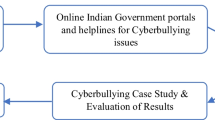Abstract
The advent and growing popularity of cyber communication is creating new negativities on online platforms, particularly cyberbullying. Cyberbullying and other cybercrimes are intertwined with cyber security. The current study is an attempt to scrutinize the association of cyber security measures adopted by the teenagers with being cyberbullied and further with the nature of their involvement. The study employed a cross-sectional survey of 1325 teenagers in the cosmopolitan society of Kolkata by stratified, random sampling design. Application of the inferential analysis like anova had been used to test the bivariate associations between different cybersecurity measures and cyberbullying of the teenagers, by the help of statistical package SPSS 22 for Windows. These associations were further analysed with the help of line and bar graphs by using MS Excel. Cyber security measures like frequency of sharing password, personal information disclosed on social networks, information disclosed to strangers on social networks, accepting invitation from strangers on social networks to meet in person, posting of private digital materials, quantity of safety measures adopted on different online platforms has been analysed. All of them appeared to be statistically significant. The result indicated strong relationship between these cyber security measures and nature of involvement of the teens in online bullying.
Access this chapter
Tax calculation will be finalised at checkout
Purchases are for personal use only
Similar content being viewed by others
References
Adams, D., Paul, C., & Barney, W. (1997). Introduction: Cyberspace and Geographical Space. Geographical Review, 87(2), 139–145.
Aftab, P. (2000). The Parent’s Guide to Protecting Your Child in Cyberspace (2nd ed.). McGraw Hill.
Aricak, T., Siyahhan, S., & Uzunhasanoglu, A. (2008). Cyberbullying among Turkish Adolescents. CyberPsychology & Behaviour, 11(3), 253–261.
Beran, T., & Li, Q. (2005). Cyber Harassment: A Study of a New Method for an Old Behaviour. Journal of Education Computing Research, 32(3), 265–277.
Blaya, C., Kaur, K., & Sandhu, D. (2018). Cyberviolence and Cyberbullying in Europe and India: A Literature Review. In P. Smith, S. Sundaram, B. Spears, & C. Blaya (Eds.), Bullying, Cyberbullying and Student Well-being in School: Comparing European, Australian and Indian Perspectives (pp. 83–106). Cambridge University Press.
Bureau of Applied Statistics and Economics, Department of Statistics and Program Implementation, Government of West Bengal. District Statistical Handbook, Kolkata (2013), 18
Burton, S. (2014). Safegaurding Children from Online Danger. In Burton, S., & Reid, J (Eds), Safegaurding and Protecting Children in The Early Years (1st ed.). New York: Routledge.
Lee, S., Bashnakova, D., & Joe, G. (2017). The 21st Century Meeting and Event Technologies: Powerful Tools for Better Planning, Marketing and Evaluation. Apple Academic Press.
Marcum, C. D., Higgins, G. E., & Ricketts, M. L. (2014). Juveniles and Cyber Stalking in United States: An Analysis of Theoretical Predictors of Patters of Online Perpetration. International Journal of Cyber Criminology, 8(1), 47–56.
Marczak, M., & Coyne, I. (2015). A Focus On Online Bullying. In A. Attrill (Ed.), Cyberpsychology (pp. 147–156). Oxford University Press.
Nunes, M. (2006). Cyber Space of Everyday Life. University of Minnesota Press.
Spivet, Bonnie. (2011). Stop Cyberbullying. Powerkids Press
Welsh Government, United Kingdom. (2011). Respecting Others: Cyberbullying. Guidance Report of Welsh Government, Guidance Document Number, 057(2011), 5–7.
Author information
Authors and Affiliations
Corresponding author
Editor information
Editors and Affiliations
Rights and permissions
Copyright information
© 2023 The Author(s), under exclusive license to Springer Nature Switzerland AG
About this chapter
Cite this chapter
Pramanick, S., Ghosh, S. (2023). Teenagers, Cyberbullying and Cyber Security Measures: An Insight in Urban India. In: Chatterjee, U., Antipova, A., Ghosh, S., Majumdar, S., Setiawati, M.D. (eds) Urban Environment and Smart Cities in Asian Countries. Human Dynamics in Smart Cities. Springer, Cham. https://doi.org/10.1007/978-3-031-25914-2_13
Download citation
DOI: https://doi.org/10.1007/978-3-031-25914-2_13
Published:
Publisher Name: Springer, Cham
Print ISBN: 978-3-031-25913-5
Online ISBN: 978-3-031-25914-2
eBook Packages: Social SciencesSocial Sciences (R0)




